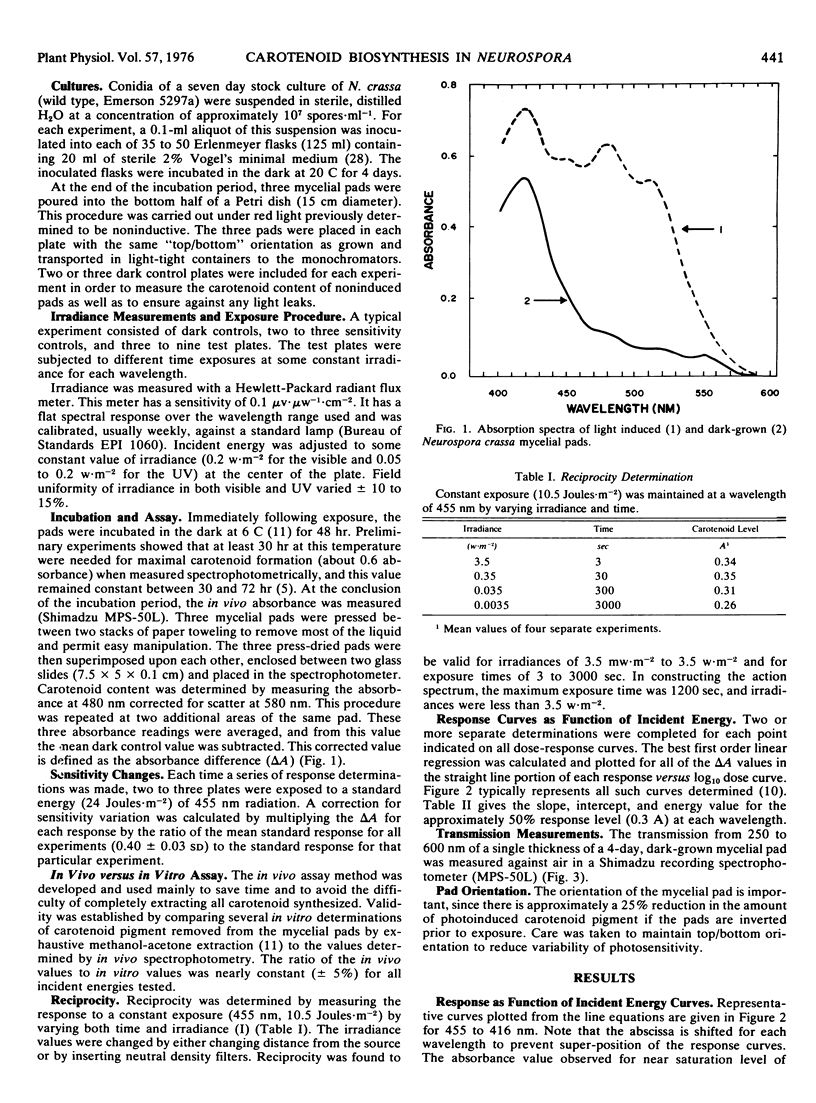Abstract
An action spectrum for light-induced carotenoid biosynthesis in Neurospora crassa was determined in 4 to 20 nm steps from 260 to 800 nm. Four-day, dark-grown mycelial pads of N. crassa were exposed to varying amounts of monochromatic radiant energy and time. After a 48-hour incubation period at 6 C, carotenoid content was assayed spectrophotometrically in vivo. The action spectrum has maxima at 450 and 481 nm in the visible range and at 280 and 370 nm in the ultraviolet. A pigment synthesized by Neurospora whose absorption spectrum resembles the action spectrum is β-carotene.
A model for the regulation of carotenoid biosynthesis in N. crassa is proposed which describes a mechanism by which β-carotene could act as a photoregulator. This carotenoid is suggested to be both photoreceptor for and regulator of carotenoid biosynthesis.
Full text
PDF





Selected References
These references are in PubMed. This may not be the complete list of references from this article.
- Anderson S. M., Krinsky N. I. Protective action of carotenoid pigments against photodynamic damage to liposomes. Photochem Photobiol. 1973 Nov;18(5):403–408. doi: 10.1111/j.1751-1097.1973.tb06440.x. [DOI] [PubMed] [Google Scholar]
- Austin D. J., Bu'Lock J. D., Drake D. The biosynthesis of trisporic acids from beta-carotene via retinal and trisporol. Experientia. 1970 Apr 15;26(4):348–349. doi: 10.1007/BF01896879. [DOI] [PubMed] [Google Scholar]
- Bergman K., Burke P. V., Cerdá-Olmedo E., David C. N., Delbrück M., Foster K. W., Goodell E. W., Heisenberg M., Meissner G., Zalokar M. Phycomyces. Bacteriol Rev. 1969 Mar;33(1):99–157. doi: 10.1128/br.33.1.99-157.1969. [DOI] [PMC free article] [PubMed] [Google Scholar]
- Delbrück M., Shropshire W. Action and Transmission Spectra of Phycomyces. Plant Physiol. 1960 Mar;35(2):194–204. doi: 10.1104/pp.35.2.194. [DOI] [PMC free article] [PubMed] [Google Scholar]
- Harding R. W., Huang P. C., Mitchell H. K. Photochemical studies of the carotenoid biosynthetic pathway in Neurospora crassa. Arch Biochem Biophys. 1969 Feb;129(2):696–707. doi: 10.1016/0003-9861(69)90230-6. [DOI] [PubMed] [Google Scholar]
- Harding R. W., Mitchell H. K. The effect of cycloheximide on carotenoid biosynthesis in Neurospora crassa. Arch Biochem Biophys. 1968 Dec;128(3):814–818. doi: 10.1016/0003-9861(68)90091-x. [DOI] [PubMed] [Google Scholar]
- Harding R. W. The Effect of Temperature on Photo-induced Carotenoid Biosynthesis in Neurospora crassa. Plant Physiol. 1974 Aug;54(2):142–147. doi: 10.1104/pp.54.2.142. [DOI] [PMC free article] [PubMed] [Google Scholar]
- Mathews-Roth M. M., Wilson T., Fujimori E., Krinsky N. I. Carotenoid chromophore length and protection against photosensitization. Photochem Photobiol. 1974 Mar;19(3):217–222. doi: 10.1111/j.1751-1097.1974.tb06501.x. [DOI] [PubMed] [Google Scholar]
- Muñoz V., Butler W. L. Photoreceptor Pigment for Blue Light in Neurospora crassa. Plant Physiol. 1975 Feb;55(2):421–426. doi: 10.1104/pp.55.2.421. [DOI] [PMC free article] [PubMed] [Google Scholar]
- Qureshi A. A., Andrewes A. G., Qureshi N., Porter J. W. The enzymatic conversion of cis-(14C)phytofluene, trans-(14C)phytofluene, and trans-zeta-(14C)carotene to more unsaturated acyclic, monocyclic, and dicyclic carotenes by a cell-free preparation of red tomato fruits. Arch Biochem Biophys. 1974 May;162(1):93–107. doi: 10.1016/0003-9861(74)90108-8. [DOI] [PubMed] [Google Scholar]
- RILLING H. C. ON THE MECHANISM OF PHOTOINDUCTION OF CAROTENOID SYNTHESIS. Biochim Biophys Acta. 1964 May 25;79:464–475. doi: 10.1016/0926-6577(64)90212-8. [DOI] [PubMed] [Google Scholar]
- Sargent M. L., Briggs W. R. The effects of light on a circadian rhythm of conidiation in neurospora. Plant Physiol. 1967 Nov;42(11):1504–1510. doi: 10.1104/pp.42.11.1504. [DOI] [PMC free article] [PubMed] [Google Scholar]
- Wald G. Molecular basis of visual excitation. Science. 1968 Oct 11;162(3850):230–239. doi: 10.1126/science.162.3850.230. [DOI] [PubMed] [Google Scholar]
- ZALOKAR M. Biosynthesis of carotenoids in Neurospora; action spectrum of photoactivation. Arch Biochem Biophys. 1955 Jun;56(2):318–325. doi: 10.1016/0003-9861(55)90252-6. [DOI] [PubMed] [Google Scholar]
- ZALOKAR M. Studies on biosynthesis of carotenoids in Neurospora crassa. Arch Biochem Biophys. 1954 May;50(1):71–80. doi: 10.1016/0003-9861(54)90010-7. [DOI] [PubMed] [Google Scholar]


